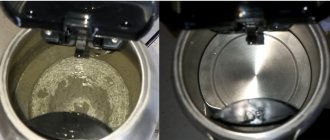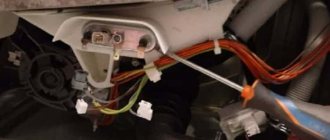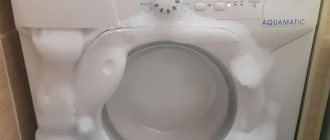The rate of sediment formation is affected by the intensity of use, frequency of washing at high temperatures, and water hardness.
High-quality regular cleaning helps to cope with the problem. To learn how to remove scale from an automatic washing machine at home, read the article.
When to clean your automatic machine?
Descaling your washing machine should be done periodically. This will avoid voluminous accumulations that impair the operation of the device and contribute to equipment breakdowns.
The visible part of the drum, into which things are placed for washing, almost always looks shiny and clean . But this circumstance has nothing to do with the condition of the heating element and the outer part of the drum.
The recommended cleaning frequency is once a quarter; if you use the washing machine very rarely, it is a couple of times a year. The hardness of the tap water affects how often preventative maintenance should be performed.
If the water in the system is hard, and washing is carried out mainly on a long cycle with high water heating, cleaning of lime deposits should be carried out more often, once every 2 or 2.5 months.
More frequent cleaning than recommended with special or folk remedies can accelerate the wear of rubber and other parts of the washing machine.
How to properly clean a washing machine from dirt and odors
- Pull the tray out until it stops. If you see that there is a blue part built into its middle compartment (in modern machines from Bosch, Samsung, Veko, etc.), then you need to press it and pull it forcefully towards you, while simultaneously supporting the container itself;
- if there is no blue part in the tray of your machine (the trays in Indesit machines are often designed this way), then you just need to pull the tray towards you and down, then slowly moving it left and right and pull it out completely.
Please note that for cleaning you need to use citric acid; lemon juice cannot replace it in any case. The procedure can be carried out no more than once every 3 months, and if the unit is not used very intensively - once every six months.
Use of special means
In addition to simple home recipes, you can use special household chemicals for descaling. Such products do not harm the washing machine itself and effectively remove lime deposits. It is necessary to use household chemicals for descaling strictly according to the instructions for the product.
MAGIC POWER
To clean the elements of the washing machine that come into contact with water and are prone to scale build-up, you can use the German product MAGIC POWER. The product is produced in Germany.
There are two release forms:
- gel;
- powder.
Application is not difficult. If a gel is selected, the procedure is as follows:
- Pour ½ to 1 bottle of product into the washing machine.
- Start washing at +60°C.
The powder is effective, due to the acids it contains, even at a temperature of +40°C. How to use the powder:
- Pour the powder into the washing powder compartment according to the instructions.
- Set the washing mode by adjusting the temperature.
- Start the wash.
The cost of the product depends on the form of release. For gel it’s 200 rubles per half-liter bottle, for powder – from 100 rubles per half-kilogram pack.
Topperr Express Cleaner
TM Topperr powder is intended for removing scale from washing machines and dishwashers. The drug is produced in small packages weighing 125 grams. Price for 1 pack – from 200 rubles.
Using this powder is very simple. Pour the entire pack directly into the drum and start washing at a heating temperature of +60°C.
Dr. Beckmann
The product is available in liquid form . In addition to removing scale, the drug helps eliminate mold and unpleasant odors.
The cleaner is poured into the powder compartment and the wash is started at +60°C. A container with a volume of 250 grams costs from 300 rubles.
How to soften water?
Soft water is not only known to improve the quality of washing results. It is much safer for the mechanical elements of the SMA. By softening the water, it is possible to help extend the life of parts that come into contact with it. More details:
- Using a special tool. It is characterized by good efficiency and accessibility. The softening composition can be purchased at any store or supermarket that sells household chemicals. They protect mechanical parts from scale formation. However, even the use of special means does not provide a 100% guarantee.
- Washing with high quality powders. Most well-known manufacturers, such as Persil, Ariel and many others, have already taken care of including emollients in their products. Their use improves the quality of washing and protects machine parts from premature wear.
- Mechanical systems. Most effective in the fight for softness. Connect directly to the water supply. These include: membrane and salt filters, magnetic softeners, ion exchange systems.
How to clean the powder compartment?
Cleaning the washing machine must be carried out comprehensively. In this case, it is necessary to pay attention not only to the heating element, but also to the powder compartment. Deposits also form on its surface and in the niche where it is inserted.
This leads to:
- hard water;
- remnants of detergent that are not completely washed;
- air conditioner residues;
- dust and other pollutants.
Incompletely rinsed residues of powder, gel and conditioner can be easily removed in warm water using a small brush.
Work order:
- Pull the container out of the hole.
- Remove the removable part in the air conditioner compartment from the cuvette.
Rinse in water.- Using baking soda and a brush, scrub the container on all sides.
- In case of significant lime deposits, it is possible to use bleach for cleaning.
- Pour hot water into a bowl of suitable size, into which the removable container fits entirely, and dilute the packet of citric acid.
- Place the cuvette in the bowl and leave for at least 1 hour. Maybe longer. If there are significant scale deposits, the cuvette can be left soaked in citric acid for several hours.
- Clean with a brush, paying attention to all joints.
- Wipe the cuvette.
- Install the removable part for the air conditioning compartment.
- Place the cuvette in place in the grooves.
It is convenient to use an old toothbrush with a small working head to clean the container.
The video will show you how to clean the powder tray from scale and mold:
External gloss
Household appliances must not only be in good working order, but also clean on the outside. This is especially important for the device, on which the cleanliness of linen and clothes depends. After cleaning the insides, they move on to adding a gloss to the outside. This does not take much time for neat users - they regularly wipe the surfaces of the case with a cloth, so the machine remains tidy. This is especially important if the equipment is in the kitchen - even greasy stains may appear on it from time to time.
For external cleaning, you will need regular dishwashing detergent and a sponge. The detergent composition is dissolved in water and the body is wiped with it. Then wipe with a dry microfiber cloth to avoid streaks.
It happens that if you do not take care of the cleanliness of the case for a long time, dust eats into the plastic. In this case, you need to apply soda slurry to the contaminated surface - let it sit for 2-3 hours. Then wipe with a sponge and rinse.
To keep the hatch door shiny, spray it with glass cleaner and wipe it - again use a microfiber cloth.
Cleaning the drain hose and filter
If cleaning is limited to just running the washing machine on a vigorous cycle (with hot water and descaling agents), the washing machine is not yet fully cleaned.
The filter and drain hose through which water leaves the device into the sewer can become clogged with various debris - lint, hair, scraps of paper and pieces of exfoliated scale.
Procedure for washing the filter:
prepare rags, a water container, napkins and brushes;- open the protective panel, which is usually located on the bottom of the façade;
- lay enough rags on the floor in this place to absorb water;
- turning the filter counterclockwise, unscrew it and remove it;
- clean it of debris and rinse it in water.
Flushing the hose is carried out as follows:
- through the drain filter, the remaining water from the machine can be drained into a prepared container, for example, into an empty jar;
- the hose is disconnected from the drain point (sewer pipe);
- Taking into account the design features, disconnect the hose and wash it.
It is recommended to clean the filter and hose at least 4 times a year, more often is better.
How to clean the filter in a washing machine, video instructions:
Is it possible to use calgon when washing baby clothes?
If there are too few things, there may be an imbalance, too much - overload. Open the powder drawer and pour a sufficient amount of detergent into the main wash compartment. You can’t pour in fabric softener, or sprinkle in Calgon or similar products.
Interesting materials:
What are adjacent sides of a rectangle? What is semantic integrity? What is Soak Off Gel Rubber Base? What is etiquette? What is the actual business substyle? What is asparagus and its beneficial properties? What are sports socks? What is a comparison in literature? What is the average salary? What is urgent histology?
Prevention of plaque
It is almost impossible to completely prevent scale formation in a washing machine. Preventive measures include the following:
- Install filters at the entrance to the house (apartment), which would purify the water from mechanical and other pollutants, and also soften its composition. One of the filtration options is a magnetic filter that can change the crystalline structure of water.
- Periodic cleaning of the washing machine from scale using one of the methods.
- Refusal to wash old items, as well as those from which lint and threads are separated. When washing, such particles quickly stick to the heating element and accelerate the formation of scale.
- Refusal to machine wash heavily soiled items - in solvents, building mixtures, etc. These substances can also stick to the heating element and contribute to the fouling of the heating element with lime.
- Frequent washing at high temperatures with a long processing cycle also contributes to the formation of scale.
Why does scale appear?
On washing machines that have been in operation for a couple of years, you can notice particles of dirt that cannot be removed with a cloth from plastic and metal surfaces.
There are several reasons for the formation of such crystallized plaque:
- For two or three years of operation of the unit, no preventive maintenance was carried out;
- The washing
used has a high content of chemical impurities; - The machine
often washes in high temperature and fast modes; - The water in the water metering unit was often turned off;
- The water used is excessively hard or unclean. The scale on the Tubular Heater is a crust of hardened magnesium and potassium salts. After a certain time, it only increases, which leads to overheating of the heater and its burnout;
- Due to the occurrence of scale in places where the machine is difficult to reach, some of its parts quickly wear out and break.
There is a simple way to help you promptly notice a problem brewing. It is necessary to look through the hole at the bottom of the drum onto the tubular heater to assess its condition. If necessary, use a flashlight. If there is a layer of scale on the heater, it’s time to clean it.
Damage from scale
Limescale causes significant harm to the washing machine, specifically:
- A tubular heater coated with scale loses heat conductivity, due to which its coil overheats and the part fails;
- The appearance of dirt in the middle of the machine leads to clogging of the drain system, which leads to its malfunction;
- Scale deposits on the internal parts of the machine reduce its working life by at least half.
Important: using inappropriate cleaning products or incorrectly cleaning the automatic machine provokes the formation of scale with even greater force. Before carrying out work on cleaning a washing machine, you should definitely consult with experts or analyze the manual for performing such work in order to do everything according to the rules. It does not matter which car is going to be cleaned - Bosch, Indesit or another brand.
Simple recommendations
You can even protect your washing machine from scale formation by using the powder correctly. Do not use hand wash powder in automatic machines. It is not recommended to put powder into the rinse aid compartment. All these actions clog the machine system and cause it to malfunction.
After washing, experts recommend turning the machine on idle. Thanks to additional rinsing, the remaining detergents are washed away, which does not allow the formation of bacteria, which reduces the service life of the equipment.
Caring for and cleaning equipment with your own hands is not so difficult. The main thing is to clean it regularly and the washing machine will thank its owners with a long service life.










